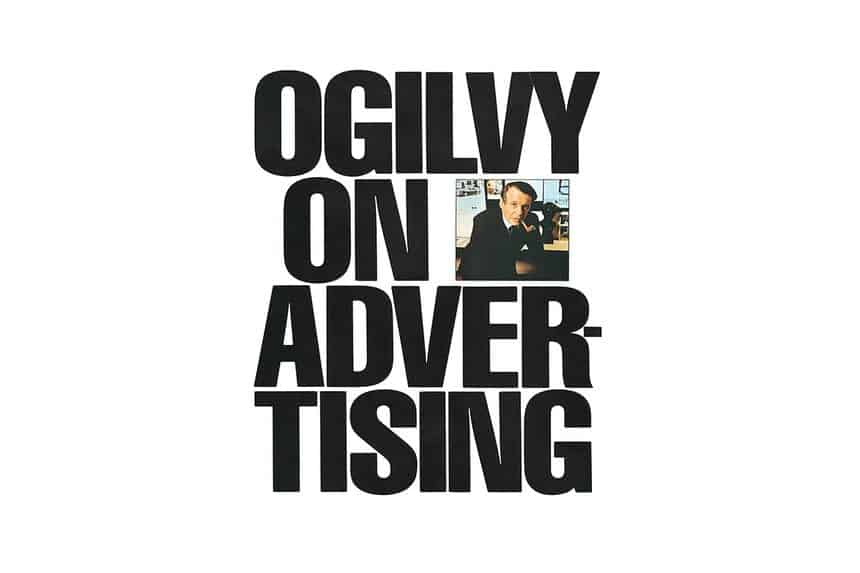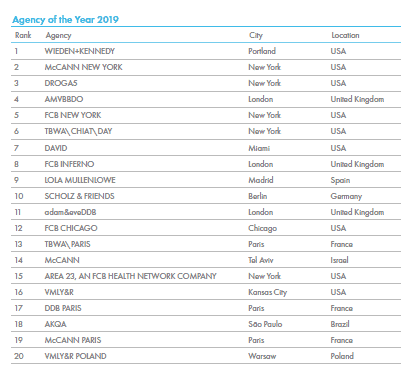David Ogilvy, the founder of Ogilvy & Mather ad agency, is probably the most famous adman that has ever lived.
When he set up his creative boutique in 1949 he strongly believed that advertising is going to change fundamentally. His intuition proved to be true because television emerged as the strongest medium and the most convincing communication channel to sell products and services.
Confessions of an Advertising Man
In his great book called “Confessions of an advertising man”, he shared principles that have guided the careers of many creative minds, but also universal rules for advertising professionals:
- How to run an advertising agency
- How to win and retain clients (protect revenue and assets)
- Tips for clients on successfully collaborating with advertising agencies
- Secrets to building great ad campaigns
- How to develop great copywriting
- Tips on how to create great posters
- Tips on creating successful TV commercials
- Words of wisdom for young admen
David Ogilvy built his ideas and beliefs on his personal incredible success, as he grew his business from a creative boutique on Madison Avenue to an international advertising network present in 40 countries at that time (currently in 83 – source).
Confessions of an Advertising Man PDF
In case you want to read the electronic version of Confessions of an Advertising Man PDF book, you can do it on academy.edu. At the same web address, you can find a good summary of Ogilvy’s book.

Ogilvy on Advertising
Later, in his most famous book called “Ogilvy on advertising”, he was pretty sure that his principles would last long after 1985.
I remember some of his principles in appliances in his book, such as “Do your homework” (meaning to study the service or product that you are a supposed to create a campaign for), or “How to recognize a big idea?” for which you are supposed to ask yourself 5 key questions:
- Did the ad make you gasp when you saw it?
- Did you wish that it was your idea?
- Is it fresh?
- Does it answer the strategic rationale?
- Would you use it for 30 years?
Of course, during the 80s creativity was simpler, straightforward, so usually, the product was the main hero in the advertisements. Today’s top awarded advertising it’s much more emotional, with levels of emotions varying from one category to another, and from country to country (due to cultural traits).
However David Ogilvy was aware that you cannot talk indefinitely to customers about the same winning creative idea, but he advised us to do so until the products stop leaving the shelves. Clearly today this period is shorter, as ideas wear off very quickly and the human attention span is shorter than the one of a golden fish (check 2019 mobile attention span studies).
There are many other facts that are not so valid anymore today, such as the average time it takes an advertising agency to create a campaign, which 35 years ago was a comfortable period of 117 days (!).
How many agencies today have today four months to create a campaign from scratch? Probably less and less every year.
Copywriters
But there are also some things which passed the test of time, and one example are the copywriters.
Ogilvy was convinced that copywriters are the most important employees in an advertising agency due to their immense curiosity, their great sense of humor, their versatility in writing any kind of advertisement, and their hard-working spirit.
Personally I think all great copywriters that I worked with would fit into Ogilvy’s 35-year-old profiling, but I would add that most of them were also charismatic, great public speakers, and strongly opinionated.
Account Executives
During the 60s David Ogilvy noticed that agencies were hiring more and more women than men in the Client Service department, which initially was dominated by men. At that time, Ogilvy& Mather New York branch included 70% women, which was a growing trend.
At the same time, he realized that the clients were competing with advertising agencies in recruiting the same candidates’ profiles. This was for them a losing battle because they could not compete financially with clients. Additionally, the role of the account executives was being reduced to coordination, as clients were hiring qualified marketing specialists.
This trend continued until today when we could barely see a man in the client service department of advertising agencies.
I was one of these men years ago, first at Saatchi& Saatchi Romania, working alongside 12 female colleagues, while and Leo Burnett I had two more male colleagues, one of us being a Group Account Director in a 25+ people department (so kind of the same <1:10 male vs. female ratio).
Not surprisingly, the Client Service department has become today a launching pad for account executives to change sides and get hired in marketing departments, usually for the clients that they were assigned to.
Researchers
The image and profile of advertising researchers probably haven’t changed during the last 4 decades.
David Ogilvy mentions quite often the fact that the creatives in the agency were somehow “allergic” to advertising research. Researchers were also criticized back then for their slow pace, for being too cautious, with low interest in advertising, while their advertising pre-testing was usually making advertisements dull.
Another critique regarding researchers in the advertising agency was that their presentations were full of incomprehensible jargon, complicated charts, and the fact they were too perfectionists.
Today we have very few researchers in the advertising agencies (probably too few for the amount of data to be analyzed), but account planners (also called strategic planners) are doing now the research jobs, and since they love creativity, their overall image is also more positive.
What are the 13 changes David Ogilvy predicted in 1985?
1. He assumed the quality of research would improve and the creative people we learn to use research know-how
I think this prediction was a bit far-fetched, especially because even back then creatives were despising advertising research activities (and it never changed). On the other hand, nowadays many copywriters and art directors have the Internet on their side, and they can check facts or find inspiration for their projects by themselves.
I bet there are many cases of creative briefings, where highly experienced creatives came up with deeper human insights than their account planning colleagues, responsible for writing the creative brief.
To conclude, I don’t think he checked his crystal ball for this first prediction. 🙂
2. Ogilvy bet on a revival of print advertising
If we are to look at circulation numbers and print runs across the globe, we know this is not the case because the Internet almost killed the print just like television almost eliminated the radio star.
So here I drew the same conclusion as for prediction no.1.
3. David Ogilvy predicted that advertising will deliver more information and that it will be more meaningful
While advertisements today have the chance to include more details than before thanks to interactive formats and video ads, I’m not sure that they are more meaningful or just cluttered.
Look for example at Google Ads copywriting – for any campaign we have to create at least 20 different ads and because we perform A/B testing and optimize them all the time, not all are great and meaningful. Today, in the digital world, ads need to be mostly eCommerce performant rather than meaningful.
For this one, I think the jury is still out.
4. Billboard advertising will disappear
Take a walk in Bucharest and you’ll see that that is not the case. Of course, my hometown is not relevant for the whole of Europe nor the world, but in every modern city, there are plenty of billboards and other out of home formats.
In central areas of any big city, classic billboards were replaced by large format digital screens, that offer richer content and draw attention more efficiently.
5. He believed that TV and radio ad clutter will be controlled
Here I think the situation varies from one country to another. For example, in the Czech Republic the 30” GRP is one of the most expensive in Europe, while in Romania where the cost/audience unit is much lower and top TV stations are often sold out.
6. David Ogilvy predicted that governmental advertising will be huge, especially in health education
If we are to judge now after the first wave of coronavirus crisis or look at The NHS UK investments in media, I would say he was a great visionary.
But if we would roll back six months ago and we would compare the health education done by NHS versus Health Ministries from Eastern Europe, I wouldn’t be so convinced that he guessed this trend.
7. Advertising will be an important factor in controlling the population explosion
Looking at the constant growth rate of the global population in the past 30 years, I would say that this was also very nice thought, but unfortunately nothing more. But who knows, maybe there will be another visionary in the coming years that will make advertising to play a major role and controlling population growth.
8. Political candidates won’t use any more dishonest campaigns
Oh my…. here David Ogilvy probably had the same disappointments with politicians the same as we experience today, all over the world.
I think that if someone will manage to fulfill this prediction, the world will be saved. 🙂
9. Advertising campaigns produced outside the US will improve at a much higher speed
Here Mr. Ogilvy was right, and we can check this by looking at different countries’ media spend, but also at creative advertising award winners at Cannes Lions, the most important global event in the ad industry.
In the picture below, you’ll see that in 2019, at Cannes Lions awards, 11 out of 20 top agencies were outside the US.

Read 2019 Cannes Lions Global Creativity PDF report: Cannes Lions publishes 2019 Global Creativity Report
10. Foreign ad agencies will enter successfully the US market
In this case, David Ogilvy was also right, as French group Publicis and Japanese group Dentsu are today strongly represented in the US, both being in the Top 5.
11. Multinational companies will increase their market shares, while their ad campaigns will be created by agencies at headquarters and adapted locally
This couldn’t be more true today. Think for example Procter & Gamble, Apple, Coca-Cola, Nike, Adidas, car brands, cosmetics brands, and many others, all of them investing in global ATL campaigns that are only adapted locally.
12. Direct response advertising will be included in advertising agencies
I remember that 14 years ago in Starcom Media Bucharest we had a Direct Marketing Director, but even now that is not a standard organizational chart.
With the rise of CRM in the past 20 years, direct response advertising tended to separate from other communication services and crystallized in new Direct Marketing agencies.
13. Television commercials will be produced at significantly lower costs
During the past 20 years, video animations and digital films managed to decrease the average production cost of TV commercials, including the cost with DOPs, Directors, locations, and props, but also to shorten production timelines.
So, in this case, I think David Ogilvy was absolutely right.
Additionally, if I would judge this prediction during the 2020 coronavirus crisis, creative agencies around the world had to cope with their clients declining marketing budgets. One of the consequences was that the average TV commercial breaks included more animations than before, instead of classic commercials with human actors.
The Verdict
So bottom line, although not all his 13 predictions prove to be true today, David Ogilvy remains not only one of the true visionaries of the advertising industry, but probably the most influential ad man in our history.

